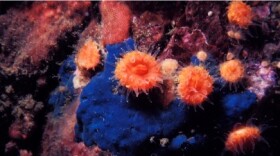Nearly 92,000 sockeye salmon returned to the Baker River this year. That’s a historic milestone for nearby tribes, state wildlife officials and the hydroelectric utility that caused the decline — and helped bring the fish back.
Scott Schuyler, the Upper Skagit Indian Tribe’s policy representative for cultural natural resources, has been watching the fish run for more than 40 years.
“We basically lost this run,” said Schuyler, a tribal member and elder. “Back in 1985 the run went down to 80-ish or so fish, which is basically extinct. And it was due to hydropower that caused their demise, and it was hydropower that helped fix the run to get to where we are today.”
Schuyler said the tribe once had a fishing village called S.báliuqʷ (pronounced 'sih-’BALL’-ih-QUE’) on Baker Lake.
“That's where people lived and died and fished and hunted since time immemorial,” he said.

Two huge hydroelectric dams put an end to the village. Completed in 1925 and 1959, they were built without fish passage. According to the utility, their design — with concrete walls that are 285 and 312 feet tall, respectively — meant that attempts to add fish ladders were unsuccessful. That's despite an early design that used a "moveable car," or tank, to lift fish and transport them around the dam.
By the mid-1980s, sockeye returns dropped to fewer than 100 a year. The Upper Skagit people had to rely on salmon from other tribes to carry out traditions and keep their culture alive.
Under federal law, the utility had to negotiate the terms for its dams’ continued operation in 2004. During those negotiations, the Upper Skagit Indian Tribe demanded that the utility work toward restoring the return, with a goal of 75,000 to 100,000 fish per year.
In 2010, Puget Sound Energy built and paid for a new hatchery and a refurbished spawning beach, where some of the fish can mate in a semi-natural environment after they're released from the hatchery.
Despite the lack of a fish ladder, the utility now works extensively to help the sockeye run recover, said Arnold Aspelund, a fisheries scientist who worked on Puget Sound Energy’s fish programs for more than three decades, including those on the Baker River System.
“We have roughly, within our current license, 10 articles specifically related to aquatic resource issues, such as fish passage, fish propagation, flow requirements, flow that requires stability within the river system,” Aspelund said.
Now, when they migrate, the fish enter a trap that sorts them into tanker trucks. They’re then driven past the dams and released into the river.

Aspelund said the utility also invests in habitat restoration beneath the dams, so the newly-hatched fish have places to bulk up and grow strong before they head out to the ocean.
“Puget is working with landowners and parties downstream of the Baker project to secure lands all along the Skagit River and to protect those for juvenile rearing,” he said.
Schuyler, with the Upper Skagit Indian Tribe, took part in the negotiations 20 years ago to relicense the dams under federal law. He said his tribe had one goal: to save this run of sockeye.
Two years ago, 63,000 sockeye returned to the Baker River system. Schuyler said getting to nearly 92,000 this year is a big deal.
He said several other salmon runs in the Skagit watershed still need help. The diminishing runs of Chinook salmon, or Kings, are especially concerning because they are the preferred prey of endangered southern resident orcas, a species that continues to decline despite decades of federal and local conservation work. But for now, the Upper Skagit tribe is celebrating the sockeyes’ rebound.
“From a cultural standpoint, I can't explain enough what it means to have our tribal members fish in their ancestral river at an ancestral village location,” Schuyler said. “They're touching their history, their culture, their past, while we're fishing there.”







